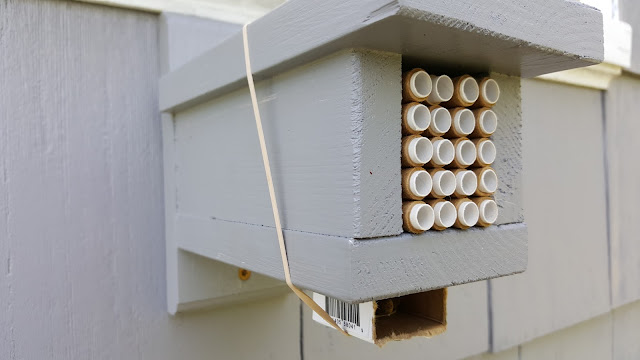We finally had a weather forecast of 5 warm days in a row without rain, so I grabbed the Mason bee cocoons out of the fridge and a rubber band and headed out to the garden shed.
Each box of cocoons has both sexes of Mason bees. The female cocoons are larger in size than the male cocoons.
I removed the end flaps off of one end of the box. Then I placed the box under the bee house and secured with the rubber band. Placing the box under the house will protect it from rain if it should rain before they hatch. The reason for attaching the cocoons to the house is that it will imprint on the bees where they need to return to make next years cocoons.
Two things to notice in the photo below. First notice how there are less cocoons in the box after just one day. Second thing to notice is the tan spots on the bee house. The lady who taught the class mentioned that we may see this on the bee house after they hatch. She said it is Mason bee semen. I can't remember why this is because I guess I was too busy thinking....WHAAAT?!!!!!
After 5 days... all the cocoons have hatched except two AND there are MORE tan spots.
I wanted to learn more about Mason bees so I checked out the Internet and found some vintage books about various bees and wasps written by a Frenchman named J H Fabre, in the late 1800's. These books were then translated to English in 1914 by Alexander Teixeira De Mattos.
I found 4 books but there are more in the series. The ones I purchased are The Mason Bees, The Mason -Wasps, The Hunting Wasps, and Bramble Bees and Others.
Two of the books have book plates in them with the name Giulio Marchetti. I think I need book plates for my books. I kind of like the simple design of this one.
I wonder if Guilio Marchetti raised bees and if he did, where? Italy perhaps. Or was he Italian by birth and immigrated to the US. The plot thickens.
Reuse Repurpose Recycle














